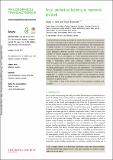Files in this item
Vocal production learning in mammals revisited
Item metadata
| dc.contributor.author | Janik, Vincent M. | |
| dc.contributor.author | Knörnschild, Mirjam | |
| dc.date.accessioned | 2021-09-07T09:30:07Z | |
| dc.date.available | 2021-09-07T09:30:07Z | |
| dc.date.issued | 2021-12-25 | |
| dc.identifier | 274006404 | |
| dc.identifier | 7ce83449-d637-4a2e-9e1b-ca07a2609463 | |
| dc.identifier | 000693558500020 | |
| dc.identifier | 85115820294 | |
| dc.identifier.citation | Janik , V M & Knörnschild , M 2021 , ' Vocal production learning in mammals revisited ' , Philosophical Transactions of the Royal Society. B, Biological Sciences , vol. 376 , no. 1836 , 20200244 . https://doi.org/10.1098/rstb.2020.0244 | en |
| dc.identifier.issn | 0962-8436 | |
| dc.identifier.uri | https://hdl.handle.net/10023/23910 | |
| dc.description.abstract | Vocal production learning, the ability to modify the structure of vocalizations as a result of hearing those of others, has been studied extensively in birds but less attention has been given to its occurrence in mammals. We summarize the available evidence for vocal learning in mammals from the last 25 years, updating earlier reviews on the subject. The clearest evidence comes from cetaceans, pinnipeds, elephants and bats where species have been found to copy artificial or human language sounds, or match acoustic models of different sound types. Vocal convergence, in which parameter adjustments within one sound type result in similarities between individuals, occurs in a wider range of mammalian orders with additional evidence from primates, mole-rats, goats and mice. Currently, the underlying mechanisms for convergence are unclear with vocal production learning but also usage learning or matching physiological states being possible explanations. For experimental studies, we highlight the importance of quantitative comparisons of seemingly learned sounds with vocal repertoires before learning started or with species repertoires to confirm novelty. Further studies on the mammalian orders presented here as well as others are needed to explore learning skills and limitations in greater detail. | |
| dc.format.extent | 10 | |
| dc.format.extent | 659237 | |
| dc.language.iso | eng | |
| dc.relation.ispartof | Philosophical Transactions of the Royal Society. B, Biological Sciences | en |
| dc.subject | Pinnipedia | en |
| dc.subject | Chiroptera | en |
| dc.subject | Primates | en |
| dc.subject | Elephants | en |
| dc.subject | Vocal communication | en |
| dc.subject | Cetacea | en |
| dc.subject | QH301 Biology | en |
| dc.subject | QL Zoology | en |
| dc.subject | T-DAS | en |
| dc.subject.lcc | QH301 | en |
| dc.subject.lcc | QL | en |
| dc.title | Vocal production learning in mammals revisited | en |
| dc.type | Journal item | en |
| dc.contributor.institution | University of St Andrews. Sea Mammal Research Unit | en |
| dc.contributor.institution | University of St Andrews. Marine Alliance for Science & Technology Scotland | en |
| dc.contributor.institution | University of St Andrews. Scottish Oceans Institute | en |
| dc.contributor.institution | University of St Andrews. Institute of Behavioural and Neural Sciences | en |
| dc.contributor.institution | University of St Andrews. Centre for Social Learning & Cognitive Evolution | en |
| dc.contributor.institution | University of St Andrews. School of Biology | en |
| dc.contributor.institution | University of St Andrews. Bioacoustics group | en |
| dc.identifier.doi | 10.1098/rstb.2020.0244 | |
| dc.description.status | Peer reviewed | en |
This item appears in the following Collection(s)
Items in the St Andrews Research Repository are protected by copyright, with all rights reserved, unless otherwise indicated.

